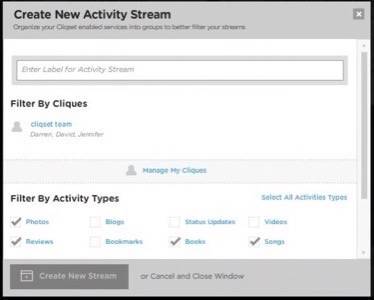Cliqset is a Florida-based technology startup that end-users have had a hard time understanding. The company just released a new product that developers should have no trouble with at all and that could send waves of innovation across the social web.

Called Cliqset FeedProxy, the service consumes user activity feeds from more than 70 online services like Twitter, WordPress, Tumblr, Last.fm, Yelp and LibraryThing and then produces an outbound feed that’s compliant with the ActivityStreams standard format.
That means activities from all those services can be read in a common language and 3rd party services can slice and dice them to create new user experiences. Several high-profile applications have already begun consuming activity feeds republished through Cliqset and the company says many more consumers are in the works.

The most common analogy for explaining the impact of data standards is the history of the railroads in the US. When all the railroad networks adopted a standard size of track, then transport companies could carry goods cross-country over multiple rail networks. That opened up a new world of commerce.
ActivityStreams is an Atom feed standard under development by many social web companies large and small. It aims to normalize the language that user activities are expressed in across multiple social networks. It’s intended to facilitate interoperability and cross-network delivery of user activity payloads. It’s important, exciting and inspiring work.
Non-standardized activity feed publishing is like creating a high-way that only one brand of car can drive on, with one proscribed type of journey in mind. Standardized feed publishing provides a platform for a world of open innovation. This API enables user data to pass freely from one network to another or through multiple applications, unhindered by network-specific markup and namespaces.
Facebook, MySpace, Netflix and other services are already making user data available in ActivityStreams format, but there are far more social networks that don’t.
As we explained in the ReadWriteWeb research report The Real-Time Web and its Future:
An extension of the Atom feed format, the spec explains it like this: “An activity is a description of an action that was performed (the verb) at some instant in time by some actor (the subject), usually on some social object (the object). An activity feed is a feed of such activities.”
In the current draft spec, you can perform such actions as Post, Share, Save, Mark as Favorite, Play, Start Following, Make Friend, Join and Tag Object. An Object could be an Article, Blog Entry, Note, File, Photo, Photo Album, Playlist, Video, Audio, Bookmark, Person, Group, Place or Comment. These actions can have such contexts as Location, Mood and Annotation. Stream aggregator Cliqset publishes Activity Streams feeds that don’t require API authentication to view. You can see a sample one at:
http://cliqset.com/feed/atom?uid=dbounds.
The aim of Activity Streams is to have multiple social networks use a common language and have a common understanding of what all those things mean, so that messages can be read across different networking sites.
Now the Cliqset FeedProxy tool will normalize feeds from more than 70 other services into new feeds in the ActivityStreams format. It may just be an initial inroad to interoperability between these networks, provided by a 3rd party and not yet extensively used – but it’s an important step none the less.
What does this mean? It means that applications developers could build interfaces to display books read, music listened to, reviews written and more across multiple different services with as much ease as they can display standard RSS or Atom feeds today. It’s a powerful new level of granularity.

Social media center Boxee and a Sun Microsystems community product currently consume activity feeds. Cliqset says many more projects are in development now.
As the ActivityStreams community builds out more sophistication in the standard, there may be things like cross-site reputation included in such feeds.
Cliqset has done a valuable service creating these normalized feeds for developers, but the obvious downside is the reliance on a middleman. Cliqset says it is talking to Superfeedr about creating some real-time feeds as well. That would be great, but would be another layer on top of existing publisher feeds.
Perhaps if the developer community builds the kind of market-moving applications and features ActivityStreams advocates expect from the Cliqset feets, more publishers will begin publishing standardized feeds natively. While Cliqset has put a lot of work into normalizing numerous network feeds, the idea behind standards is that they can facilitate technical integration between parties with no prior knowledge of each other.
Either way, Cliqset is putting the ActivityStreams agenda to the test. The company’s release could have some very significant consequences.

















